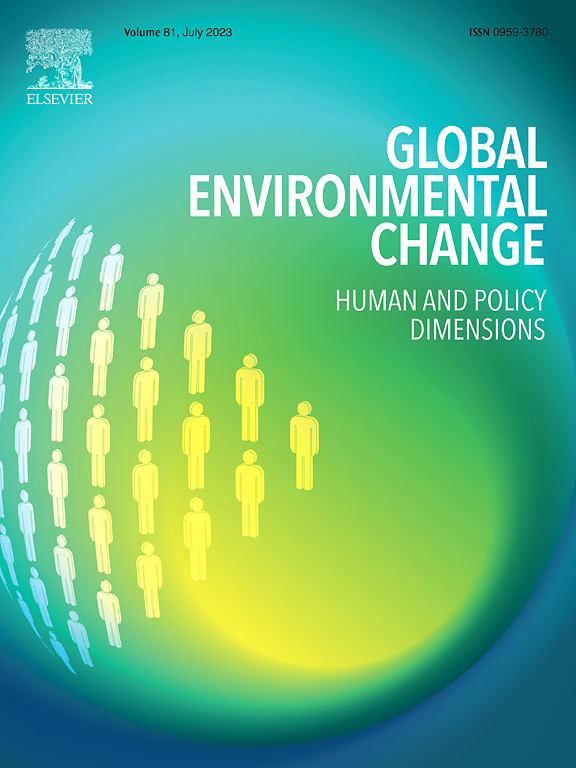The financialization of rivers: Clean Development Mechanism (CDM) subsidized hydropower in the Mekong Region’s basins at risk
IF 9.1
1区 环境科学与生态学
Q1 ENVIRONMENTAL SCIENCES
引用次数: 0
Abstract
The Kyoto Protocol’s Clean Development Mechanism (CDM) is a key carbon offset scheme that underpins the global carbon market. This mechanism leaves out many other non-carbon considerations, including the impacts of the CDM on water governance. The CDM produces credits primarily through energy projects and CDM funded hydropower is one of the most significant outcomes of nearly two decades of carbon financing with funding subsidizing over 1,000 large-scale dams. This research maps these rapidly built infrastructure projects in transboundary river systems, which has shown to have direct links to increasing hydropolitical tensions. The Mekong Region’s Irrawaddy, Bei Jiang/Hsi, Red, and Salween rivers are all considered to be amongst the world’s river basins considered ‘very high risk’ for conflict. Our research shows that these ‘very high risk’ rivers were the top four river basins to receive CDM funded large-scale hydropower. These four basins at ‘very high risk’ along with the Mekong River were the top five recipient rivers of 274 CDM subsidized large-scale dams. These dams were rapidly financed and constructed in the upstream catchments in the name of carbon reduction claims in China and Europe. This response to climate change enhances power imbalances and raises the risk of hydropolitical tensions as Mekong communities shoulder the costs of increasing insecurities in the name of distant carbon reduction claims in Europe and Beijing.
河流的金融化:清洁发展机制(CDM)资助了湄公河地区处于危险中的流域的水电
京都议定书》的清洁发展机制(CDM)是支撑全球碳市场的主要碳抵消计划。该机制忽略了许多其他非碳因素,包括清洁发展机制对水资源治理的影响。清洁发展机制主要通过能源项目产生信用额度,而清洁发展机制资助的水力发电是近二十年碳融资的最重要成果之一,为 1000 多个大型水坝提供了资金补贴。这项研究描绘了这些在跨境河流系统中快速建设的基础设施项目,研究表明,这些项目与日益紧张的水文政治局势有着直接联系。湄公河地区的伊洛瓦底江、北江/西江、红河和萨尔温江都被认为是世界上冲突 "高危 "流域之一。我们的研究表明,这些 "极高风险 "河流是获得清洁发展机制资助的大型水电项目最多的四个流域。这四个 "极高风险 "流域和湄公河是 274 座清洁发展机制补贴大型水坝的前五大受援河流。这些大坝以中国和欧洲的碳减排要求为名在上游流域迅速融资和建设。这种应对气候变化的措施加剧了权力失衡,并增加了水文政治紧张局势的风险,因为湄公河流域的社区以欧洲和北京遥远的碳减排要求为名,承担着日益不安全的代价。
本文章由计算机程序翻译,如有差异,请以英文原文为准。
求助全文
约1分钟内获得全文
求助全文
来源期刊

Global Environmental Change
环境科学-环境科学
CiteScore
18.20
自引率
2.20%
发文量
146
审稿时长
12 months
期刊介绍:
Global Environmental Change is a prestigious international journal that publishes articles of high quality, both theoretically and empirically rigorous. The journal aims to contribute to the understanding of global environmental change from the perspectives of human and policy dimensions. Specifically, it considers global environmental change as the result of processes occurring at the local level, but with wide-ranging impacts on various spatial, temporal, and socio-political scales.
In terms of content, the journal seeks articles with a strong social science component. This includes research that examines the societal drivers and consequences of environmental change, as well as social and policy processes that aim to address these challenges. While the journal covers a broad range of topics, including biodiversity and ecosystem services, climate, coasts, food systems, land use and land cover, oceans, urban areas, and water resources, it also welcomes contributions that investigate the drivers, consequences, and management of other areas affected by environmental change.
Overall, Global Environmental Change encourages research that deepens our understanding of the complex interactions between human activities and the environment, with the goal of informing policy and decision-making.
 求助内容:
求助内容: 应助结果提醒方式:
应助结果提醒方式:


